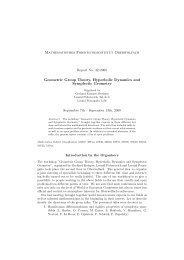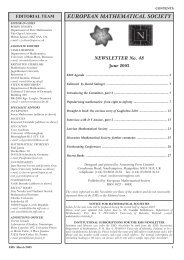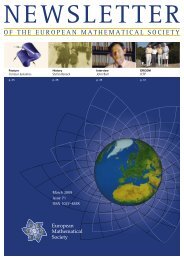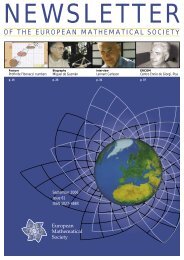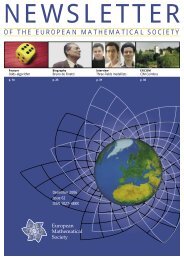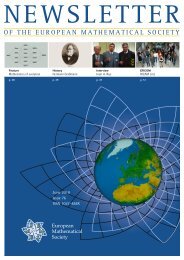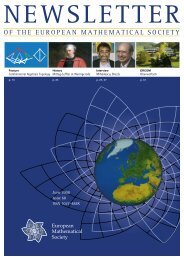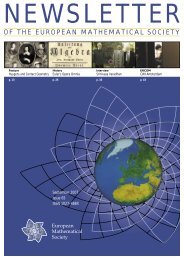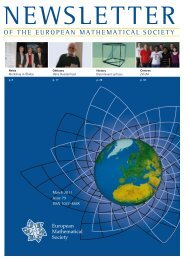Introduction to Teichmüller theory, old and new, II
Introduction to Teichmüller theory, old and new, II
Introduction to Teichmüller theory, old and new, II
Create successful ePaper yourself
Turn your PDF publications into a flip-book with our unique Google optimized e-Paper software.
16 Athanase Papadopoulos<br />
above a critical value, the local <strong>to</strong>pological model of π is the map (z1,z2) ↦→ z 2 1 + z2 2<br />
from C 2 <strong>to</strong> C, in the neighborhood of the origin. (In this picture, the criticial value<br />
is the origin.) The fibers of π above the critical values are singular surfaces, <strong>and</strong> a<br />
singular point on such a surface is called a nodal point. A nonsingular fiber is a closed<br />
orientable surface called a generic fiber. The genus of a Lefschetz fibration is, by<br />
definition, the genus of a regular fiber. (Recall that restricted <strong>to</strong> the complement of<br />
the critical values, a Lefschetz fibration is a genuine fibration, <strong>and</strong> therefore all the<br />
generic fibers are homeomorphic.) In some sense, a nodal point is a singularity of the<br />
simplest type in the dimension considered; it is the singularity that appears at a generic<br />
intersection of two surfaces. Such a singularity naturally appears in complex analysis.<br />
In a Lefschetz fibration, a singular fiber is obtained from a nearby fiber by collapsing<br />
<strong>to</strong> a point a simple closed curve, called a vanishing cycle. The vanishing cycle, when<br />
it is collapsed, becomes the nodal point of the corresponding singular fiber.<br />
A natural way of studying the <strong>to</strong>pology of a Lefschetz fibration π : X → S is <strong>to</strong><br />
try <strong>to</strong> figure out how the fibers π −1 (s) are glued <strong>to</strong>gether in X when the point s moves<br />
on the surface S, <strong>and</strong> in particular, near the critical values, since the complication<br />
comes from there. This leads <strong>to</strong> a combina<strong>to</strong>rial problem which in general is nontrivial,<br />
<strong>and</strong> the mapping class group of a generic fiber is an essential ingredient in this<br />
s<strong>to</strong>ry. It is here that the study of Lefschetz fibrations gives rise <strong>to</strong> interesting problems<br />
on mapping class groups. For instance, Lefschetz fibrations were the motivation of<br />
recent work by Endo & Kotschick <strong>and</strong> by Korkmaz on commuta<strong>to</strong>r lengths of elements<br />
in mapping class groups. Lefschetz fibrations also motivated the study of questions<br />
related <strong>to</strong> “fac<strong>to</strong>rizations of the identity element” of a mapping class group, that is, an<br />
expansion of this identity as a product of positive Dehn twists.<br />
I would like <strong>to</strong> say a few words on monodromies <strong>and</strong> on fac<strong>to</strong>rizations, <strong>and</strong> this<br />
needs some notation.<br />
Let P ⊂ S be the set of critical values of a Lefschetz fibration π : X → S.<br />
We choose a basepoint s0 for the surface S, in the complement of the set P . The<br />
fiber π −1 (s0) is then called the base fiber <strong>and</strong> we identify it with an abstract surface<br />
F . There is a natural homomorphism ψ, called the monodromy representation<br />
from (π1(S − P),s0) <strong>to</strong> the mapping class group of F . This homomorphism is the<br />
main algebraic object that captures the combina<strong>to</strong>rics of the Lefschetz fibration. It is<br />
defined by considering, for each loop γ :[0, 1] →S based at s0, the fibration induced<br />
on the interval [0, 1] (which is a trivial fibration), <strong>and</strong> then taking the iso<strong>to</strong>py class<br />
of the surface homeomorphism that corresponds <strong>to</strong> the gluing between the fibers of<br />
π above the points γ(0) <strong>and</strong> γ(1). The resulting monodromy representation is a homomorphism<br />
ψ from (π1(S − P),s0) <strong>to</strong> the mapping class group of F , <strong>and</strong> it is well<br />
defined up <strong>to</strong> conjugacy. Two Lefschetz fibrations are isomorphic if <strong>and</strong> only if they<br />
have the same monodromy representation (up <strong>to</strong> an isomorphism between the images<br />
induced by inner au<strong>to</strong>morphisms of the mapping class groups of the fibers, <strong>and</strong> up <strong>to</strong><br />
isomorphisms of the fundamental groups of the bases of the fibrations). The detailed<br />
construction of the monodromy representation is recalled in Chapter 8 of this volume.




